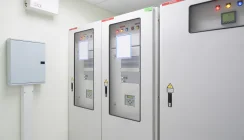How to set up a Server Room for your Business
There is a growing demand for bespoke on-site server rooms as many businesses implement a blend of office-based and remote working for their employees. Whilst some of these organisation’s applications have moved to the Cloud, they have locally based services that employees can only access through office-based servers.
Rather than commit to a full move to the Cloud, many businesses are implementing a hybrid approach and investing in their IT systems accordingly. They are adopting an approach that combines Cloud-based services from established providers including Microsoft and Google for their general office systems, and on-site servers to support more specific applications and departmental functions including finance, engineering, manufacturing, and technical operations.
Dependent on the size of their IT operation, there are solutions available that can make best use of the spaces that these companies can provide.
Acoustic Server Racks
The issue for many organisations is how best to provide a secure space in which to run their local IT networks and ensure their availability and uptime. Even if there are only one or two servers to house, they cannot be left within an open office space. Their cooling fans can generate audible noise that can be off-putting to people working locally, their heat output will add to the overall room ambient, and they will need some form of power protection from power outages.
For organisations without the space for a computer or server room, an acoustic server rack can offer a low-cost approach to housing IT servers. This type of server rack has acoustic noise-reducing foam lining the inside, which can reduce noise output from the IT servers placed within by around 20dB at 1m.
Super-silent cooling fans, built into the rear of the server rack, expel the heat generated by the servers. The maximum heat load is around 3kW and so this limits the quantity and size of IT servers that can be placed within a single rack. The exhausted air is also ‘hot’ and is expelled into the room where it adds to the local air conditioning demand.
Custom-built Server Rooms
Sometimes companies have a small room that can be converted into a server room or they have an area that could be used for this within the wider office. The design & build principles for this type of space, are like those for a data centre in terms of providing a secure and managed environment.
Computer Room Cooling Systems
The first consideration must be cooling. Any allocated space must be partitioned off to create the server room. As it will be used to house heat generating servers, cooling must be considered. The recommended temperature for a data centre or room is 18-27⁰C and in a small computer or server room, a split system wall mounted air conditioner is the preferred approach.
A typical computer room up to 3×3m can be cooled by a 2-3kW air conditioner dependent upon the total heat load. This is comprised of the total kW (kilowatts) power demand of the IT servers plus additional factors that consider room orientation, windows, and people in the room.
A split air conditioning system consists of a header unit, pipework, and a heat exchanger. The header unit is installed inside the server room as a wall mounted unit and is connected by a pipe run to an external heat exchanger. The heat exchanger may be on an outside wall or installed on a roof top.
Whilst it is relatively straightforward to size the air conditioner, design issues can occur when it comes to pipe runs and the location and installation of the heat exchanger. In rented office spaces, landlords must be consulted, and permission sought to install the new heat exchanger onto the outside of an external wall or on the roof of the building. An alternative could be to ‘tap’ into an existing building-wide air conditioning system.
Air conditioners for computer and server rooms typically range from 2 to 15kW and can be installed as single systems or as N+1 standby duty cycle for added resilience. In an N+1 configuration, both heat units share the load or operate alternative weeks. If one unit fails, the other can take up the full load.
More information on server room temperature requirements: https://tc0909.ashraetcs.org/documents/ASHRAE_TC0909_Power_White_Paper_22_June_2016_REVISED.pdf
Computer Room Floors
A typical raised access floor type is 600mm wide and deep. A small computer or server room may not have a raised access floor but considering should be given to the flooring materials. Office carpet materials can create static and release microfibres that can be draw into server fans. An anti-static material is often preferred such as a matting or floor tile. The use of a standard floor tile size can also assist the design as a grid approach (600×600) can be used to assess room and server rack layout.
Server Racks and Cabinets
In the computer or server room, IT servers and networking devices are typically housed in a 19inch server rack or server cabinet. A typical server rack range will include 600 and 800mm wide racks, 600, 800 or 1000mm deep with heights from 2U to 47U. A typical server room rack is 600mm wide by 800mm deep. The ‘U’ size refers to the height where 1U = 44.45mm. All rack mount IT devices including UPS systems have a U height and adding these together provides the total height of the cabinet required.
Care should be taken when selecting a rack to ensure it can (1) be delivered to the room from the roadside and (2) is within the ceiling height of the room. Flat packed server racks are available for assembly on site and around 1-2hours should be allowed to safely assemble a server rack. Door widths and heights, lift sizes and stairways may lead to the need for a flat packed rack delivery.
The ceiling height within a computer or server room will also determine the U-size of cabinet(s) that can be installed. As will the routing of networking cables into the rack. Even if there is no raised access floor, bottom cable entry may be preferred over top cable entry into the rack. Top entry may require overhead cable trays or cables to be run in suspended ceiling voids.
Server Room UPS Power Protection
The size of the IT load not only determines the requirements for cooling but also power within the room and the electrical installation requirements. The room should have its own sub-distribution panel from which the key electrical circuits are powered including air conditioning, lighting, and IT loads.
IT loads should be protected from power outages using an uninterruptible power supply. This can be sized to include the air conditioning if there is no local standby power generator or energy storage system. The UPS could be floor standing or rack mounted but must have a battery sized to cover either the time required to initiate and complete an orderly server shutdown, the start-up period of a standby generator or to ride-through power outages. Most server room UPS are installed with a 10-60minute battery pack dependent upon space. Longer runtimes are available up to several hours.
In terms of remote communications, the UPS system should be installed with a UPS monitoring card with SNMP and connected to the local IT network. An external bypass may also be considered to isolate the UPS during maintenance without disruption to the load.
Fire Suppression Systems
A small computer or server room may not require its own fire suppression system. Insurers can typically provide guidance here based on the room size and concentration of IT and kW demand. Where fire suppression is required, the room may require either an automated or manually activated extinguisher. An automated system using PAFSS technology provide a cost-effective solution for one or more server racks. This consists of a pressurised agent in a cannister that sits alongside the racks and a distribution hose inside the cabinet(s). The hose will melt open at the greatest heat point to release the fire extinguishing agent into the cabinet.
Environmental Monitoring Systems
Consideration should also be given to environmental monitoring. Server room temperature and humidity are commonly monitored environmental factors. A base monitoring unit is installed with the appropriate sensors. If these pick up a reading outside a pre-set threshold the environment monitoring system can be configured to issue an alert to a predefined email and SMS text distribution list. Other environmental factors that can be monitored include water leakage, smoke, and fire, as well as room security and entry into a server cabinet. Motion cameras can also be installed and connected to a suitable environmental monitoring system to provide CCTV footage post and pre-event and two-way comms into the server room.
Micro Data Centres
Micro data centres are self-contained and managed IT environments that can be easily deployed to a prepared site. MDCs are suited to applications requiring the computing power of a data centre in applications including Edge, Internet of Things (IoT) and Industrial Internet of Things (IIoT). Micro data centres area available for commercial offices, data centres and remote harsh environments. As well as being able to tackle noise concerns, they can also provide an ideal solution where there are also dust, temperature and humidity challenges. Micro data centres can provide a cost-effective solution compared to a custom-built server room dependent upon the critical infrastructure systems they include and the size of the project.
Summary
It is relatively easy to create a custom-built space to house IT servers and networking devices. The design & build practices are those adopted for a larger server room and data centre, scaled to meet project and budget requirements. A site survey is recommended to identify issues to be solved during the installation and which could affect the overall cost and success of the project. Typical issues include delivery access, electrical circuit loading, wall and partition suitability, cabling routing, cooling pipe runs, where to place a heat exchanger and how to monitor the completed server room. For a free site survey or project discussion please contact our projects team.

























